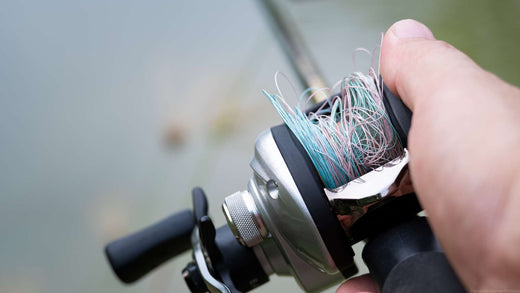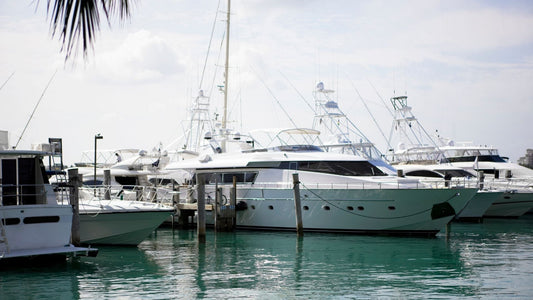
Why is My Fishing Line Webbing? Causes and Solutions for Fishermen
Nicholas HeislerShare
Few things are as frustrating for anglers as casting out their line, only to find it tangled, twisted, or worse-webbing. Webbing is a common issue where the fishing line seems to form knots, loops, or snags, resulting in a messy spool that's difficult to cast and retrieve. Understanding why this happens and how to prevent it can save time and effort on the water. In this guide, we'll explain the causes of fishing line webbing and provide practical solutions to fix and avoid this issue in the future.
What is Fishing Line Webbing?
Fishing line webbing refers to the formation of loops, tangles, or clumps in the line, often leading to knots or birds' nests on the reel. This can happen with any type of fishing line, but it's more common with monofilament and braided lines. Webbing not only reduces casting distance but also increases the risk of line breakage, which can lead to losing fish or tackle.
Common Causes of Fishing Line Webbing
Several factors can cause fishing line webbing. Identifying the cause is the first step to solving the problem.
1. Improper Spooling
One of the most common reasons for fishing line webbing is incorrect spooling of the line onto the reel. If the line is not loaded with the right amount of tension or if it's overfilled, it can create slack or loops that result in tangles during casting.
- How to fix it: Make sure the line is spooled tightly and evenly on the reel. If you're unsure, have a professional at a tackle shop spool your reel, or follow manufacturer instructions carefully.
2. Twisted Line
Line twists are a major culprit in causing webbing, especially with spinning reels. Twisting can occur during casting, retrieving, or when attaching lures incorrectly.
- How to fix it: To untwist your line, remove any bait or tackle from the line and let it trail behind the boat (or in the water with no resistance) for several minutes. This will allow the twists to naturally unwind.
3. Casting with Slack Line
Casting with a slack line can lead to loops and webbing. This typically happens when there's not enough tension on the line during the cast, causing it to spool unevenly.
- How to fix it: Always ensure there's enough tension on the line during your cast. Practice smooth, controlled casting motions to prevent slack from building up.
4. Line Memory
Some types of fishing lines, particularly monofilament, have something called "line memory." This means the line retains the shape of the spool, leading to loops or webbing, especially after it's been stored for a while.
- How to fix it: To reduce line memory, stretch out the line before fishing by pulling out a long section and giving it a gentle stretch. You can also soak the spool in warm water for a few minutes before heading out to fish, which softens the line and reduces memory.
5. Reeling Against Drag
Another common mistake that causes line webbing is reeling in when the drag is engaged and the line is being pulled out. This leads to loose line on the reel, which can later create loops and tangles.
- How to fix it: Never reel in while the drag is being pulled out. If a fish is running, let it take the line, and only reel in once you regain control.
What to Do When Your Fishing Line Webs
If you find your line is already webbing, follow these steps to fix the problem and get back to fishing.
- Cut Out the Tangled Section: If the line is too tangled or knotted, it may be best to cut out the affected section. Use sharp scissors or a line cutter to remove the damaged part and re-tie your tackle.
- Check for Line Damage: Webbing can cause abrasions on the line, weakening it. Inspect the line for any signs of wear, fraying, or kinks. If you notice damage, cut away that section to prevent breakage during fishing.
- Manually Unwind the Loops: If the webbing is minimal, you can unwind the loops manually. Open the bail (for spinning reels) or release the tension, and pull out the tangled section until the loops are straightened.
- Respool If Necessary: In severe cases, you may need to respool your reel. Make sure to apply steady tension and ensure the line is evenly distributed across the spool. A line spooling machine can help with this if available.
Tips to Prevent Future Webbing
Preventing fishing line webbing is easier than dealing with it on the water. Here are some tips to keep your line in top condition:
- Use Line Conditioner: Spraying a line conditioner on your spool can help keep the line smooth and prevent tangles.
- Choose the Right Line: If webbing is a persistent issue, consider switching to a different type of line with lower memory, such as fluorocarbon or braided line.
- Don't Overfill the Spool: Leave some space between the line and the lip of the spool. Overfilling leads to more opportunities for loops to form during casting.
- Regularly Stretch Your Line: Every few trips, take a few minutes to stretch your line. This helps reduce memory and prevents loops from forming.
Casting a Web-Free Line
Fishing line webbing is a common but avoidable problem for anglers. By understanding the causes-whether it's improper spooling, twisted line, or slack casting-and implementing the right solutions, you can keep your fishing line smooth and trouble-free. Taking preventative steps like spooling correctly, using line conditioners, and avoiding overfilling your reel can make a big difference in your fishing experience.
Related Posts You May be Interested in:
- Why Do Fishing Boats Have Insulators on Their Lines?
- How to Get Lures Deeper When Trolling
- An Introduction to Offshore Fishing
When it comes to keeping your fishing boat clean, look to Captains Preferred Products' boat cleaners and chemicals. Find everything you need to keep your vessel squeaky clean all season - always at the best prices.




